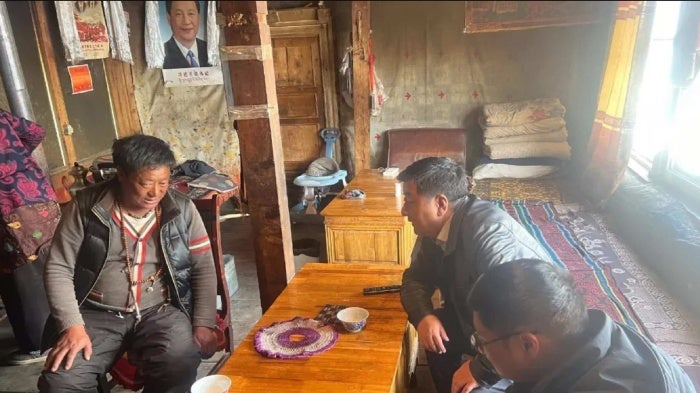摘要
从2016年起,中国政府突然大幅加速对西藏农牧民的迁移安置。 政府声称相关安置措施(通常把他们迁移到数百公里之外)纯属自愿性质,而且有助于“改善人民生计”、“保护生态环境”。
本报告依据2016年至2023年的逾千则中国官方媒体报导以及政府出版物和实地学术研究,指出中国国内媒体对许多案件的报导均与官方依法取得被迁移者同意的说法背道而驰。
新闻报导显示,藏区“整村迁移”项目实际上是强迫参与的。 据这些报导描述,许多藏人非常不愿意随村搬迁。 例如其中一个村子,全村262户当中有200户起初不愿搬迁到将近1千公里外的新地点。 另一个已排定搬迁的村子,除了一名共产党积极分子之外,所有村民原本都不同意搬迁。 但无一例外地,所有搬迁案件据报道都在最后得到村民同意。 人权观察至今未发现任何一个预定搬迁的村子或个别村民能够免于被搬迁。
官方媒体报导显示,官员采用各种极端的说服方式(即强制手段)施压农牧民同意整村迁移。 这些手段包括:反覆的家庭访问;否定村民有足够智力为自己做决定;暗示可能遭受惩罚;禁止批评;以及威胁地方官员若未达标将予纪律处分。 在某些案例,为了获得村民 “同意”而登门拜访的官员级别逐步升高,有时家庭访问长达数年不间断。 人权观察取得的一些官方新闻报导和影片显示,官员向居民扬言若不搬家就切断他们目前住所的基本服务。 另一些报导显示,当局公然威胁抗议搬迁的村民,指控他们“散布谣言”,并命令官员对这种行为予以“迅速、坚决”的打击(意味行政和刑事处罚)。 本报告包含三个案例研究,详尽说明获得整村居民 “同意”搬迁的时程、目标、论点和方法。
这些强制手段源自上级当局对地方官员施加的压力,上级当局通常将搬迁计画描述为中央或西藏自治区政府直接下达的一项毫无商量余地的重大政治任务。 这使得地方官员在地方层级的实施上毫无弹性,而且地方官员被要求取得受影响村民全体同意才能执行搬迁。
除了整村迁移,西藏还有第二种搬迁形式──分散搬迁。 这种形式的搬迁通常是由官员挑选较贫困的家庭,将他们搬迁到更适合赚取收入的地区。 虽然村民可以拒绝搬迁,但人权观察在许多案例中发现,官员会提供搬迁可获经济利益的误导资讯以获取这些家庭的同意。 根据先前项目经验,官员们应已明了许多农村人口在搬迁后将无法在新环境中找到可持续的工作。
即使由中国官方学者在西藏搬迁地点进行的调查(通常不会批评政府)也得出不同结论,即许多被搬迁者“找不到合适的工作来养家糊口”,而且“对搬迁的满意度偏 低”。 2014年对先前西藏自治区东部搬迁计画的一项审查发现,即使经过十年,仍有百分之69的被搬迁者面临财务困难,百分之49希望搬回草原上的老家。 地方官员故意向西藏农牧民提供搬迁具有经济利益的误假资讯,从而造成过分期望,可能是导致人们不满的原因之一。
无论是整村或分散搬迁,中国法律都要求被搬迁人拆除原有住房,以阻止他们迁回。 我们的研究发现,西藏官员经常强制执行这条规定。
官方统计显示,中国当局将在2000年至2025年之间搬迁安置藏族农牧民逾93万人(见附录一)。 其中大部分的搬迁(逾709,000人,即搬迁总数百分之76)发生在2016年以后。
同样在2000年至2025年这段期间,有336万藏族农牧民受到其他政府计划影响而被要求重建住房,若属游牧民则必须改采定居生活方式,不一定需要搬迁。
鉴于中华人民共和国农村地区共有455万藏族居民,前述数据显示绝大多数藏族农牧民都曾在过去二十年中受到中国政府住房搬迁或重建政策的影响。 许多藏人被迫多次搬迁或重建家园。
尽管大规模居民搬迁也发生在中国其他地区的贫困农村,但西藏社区可能因这些行动遭受毁灭性影响。 与当前中国政府将西藏教育、文化和宗教融入 “中华民族”的计划相结合,对农村社区的搬迁将对西藏文化和生活方式造成侵蚀或重大损害,特别是因为西藏的大多数搬迁计划均涉及 将农民和牧民迁移到他们无法从事原本生计的地点,从而使他们别无选择只能转向非农产业寻求工资劳动职缺。
西藏的搬迁计画违反国际人权法标准。 国际法禁止“强迫搬迁”,即在未予适当形式的法律或其他保护之下,违背个人、家庭或社区的意愿将其迁离住所或土地。 强迫搬迁还包括缺乏有意义的协商或赔偿,以及未考虑“所有可行替代方案”的搬迁。 另一方面,合法搬迁也必须遵守相关国际人权法并“遵循合理性和相称性的一般原则”。
如本报告详述,中国政府施压或强迫藏人搬迁的政策未达前述标准。 当局既未在搬迁之前探讨“所有可行替代方案”,也未确保被搬迁者得到“足够赔偿”、在不满意时有权返回或其他程序保障。
建议
对中华人民共和国政府
涉及西藏搬迁项目的各个有关当局应该:
- 暂停西藏搬迁项目,直到现行政策措施经独立专家审查确认符合中国法律、标准以及有关强迫搬迁的国际法。
- 确保所有搬迁均以符合国际人权标准的方式实施,包括在搬迁前探讨 “所有可行替代方案”,给予适当赔偿,以及向受影响者提供法律救济和法律援助。
- 停止强制或以其他不当压力使人同意政府搬迁计画,并适当处罚或起诉任何如此做的官员。
- 取消所有要求官员说服一定人数同意搬迁的配额、期限或指标。
- 处罚任何向预定被搬迁者提出无根据或未核实的搬迁利益的官员。
- 停止要求被搬迁者拆除其原有住房。
- 支持学术机构在搬迁前和搬迁后针对居民意见定期执行并发表独立的学术调查,并根据居民观点采取改善措施。
- 为可能被搬迁者提供免费实地考察可能搬迁地点的机会。
- 与可能被搬迁者进行定期、包容性的咨询,包括关于选址偏好的咨询。
- 承认并维护言论、集会和结社自由权,确保藏人和其他人能够参与表达关切和批评(包括针对政府搬迁政策)的和平活动。
- 允许受搬迁影响的人返回原本土地或就近安置以继续从事原本生计活动。
- 应多位联合国特别报告员的要求,允许访问所有藏区。
- 根据《经济、社会及文化权利国际公约》修改中国相关法律,确保其符合有关强迫搬迁的国际标准。
对联合国人权理事会和其他联合国机构
- 联合国人权理事会应采纳逾50位联合国独立人权专家的建议,对中国政府在西藏、新疆、香港和全中国犯下的人权侵害进行公正、独立的调查。
- 联合国人权事务高级专员应本于其独立监测与报告的职权,就西藏人权状况收集资讯、就其发现公开表达关切、研拟报告,并定期向人权理事会汇报。
- 联合国特别程序应本于各自职权,持续记录并公开报告中国当局在西藏的人权侵犯。
对外国政府
- 敦促中国政府尊重藏人的言论、集会与结社自由权,以便他们能向政府提出质疑,包括有关搬迁政策的议题;
- 呼吁中国政府按照多位联合国特别报告员的请求,允许他们访问西藏。
